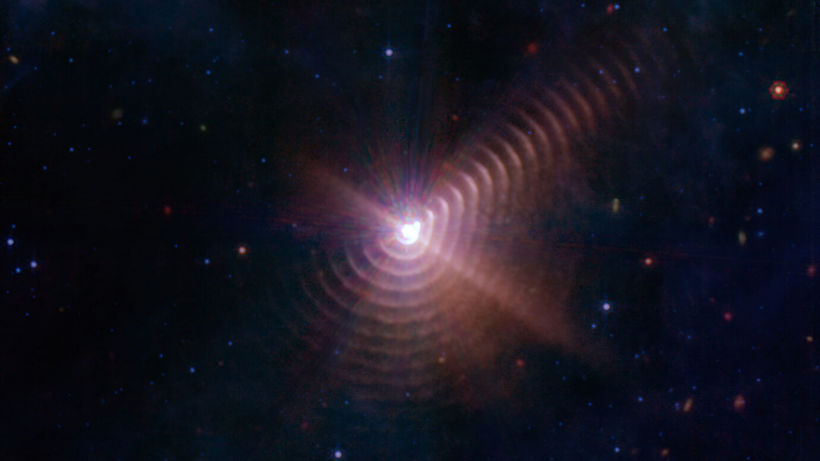For the first time, astronomers had already witnessed directly how powerful light from stars may 'push' materials. This discovery was discovered by scientists from the Universities of Cambridge and Sydney while studying a large cloud of dust produced by the violent collisions of several big stars.
A couple of stars located within our galaxy are demonstrating ways light moves stuff throughout. It's the very first time anybody has witnessed firsthand how well the intensity of energy from stars affects the movement of particles in space.
This radiation pressure affects how the dust settles in regions surrounding young stars and controls the development of clouds of gas surrounding supernova explosions, as per Science News. The findings, which were obtained using infrared photos of the binary star system WR140 acquired over 16 years, were published in the scientific journal Nature.
The Radiation Pressure and Prior Studies
In a supplementary analysis of WR140, reported in Nature Astronomy, NASA's James Webb Space Telescope (JWST) was able to look considerably further to capture a picture of more than just a single speeding cloud of dust, but over 20 of them, nestled within each other similar to a big set of onion skins.
WR140 is mainly composed of a massive Wolf-Rayet star and a significantly larger blue supergiant star that are gravitational pull locked through an eight-year orbit. The binary star in the Cygnus constellation has already been studied for two decades employing one of the world's biggest optical telescopes at Hawaii's Keck Observatory. WR140 blows up plumes of dust that span several hundred times the distance between the Earth and the Sun. These dust plumes, which occur every eight years, provide astronomers with a once-in-a-lifetime opportunity to study how starlight affects matter, as reported by Newsbreak.
It is well understood that light has velocity and exerts a force on material defined as radiation pressure. Astronomers frequently see the result of this phenomenon in the form of stuff speeding across the universe, but it's a challenging process to capture in the act. Precise recording of movement owing to variables apart from gravity is uncommon, and certainly not in such a stellar setting.

Astronomers have observed directly for the first time how intense light from stars can ‘push’ matter. Researchers from the universities of Cambridge and Sydney made the observation when tracking a giant plume of dust generated by the violent interactions between two massive stars.
ALSO READ: NASA Stops Moon Dust, Cockroach Corpses Auction, Demands Auctioneer to Return Lunar Samples
Interferometry Imagery Method
"It's difficult to perceive starlight-producing speed since the force decreases with range and other pressures soon take over," explained Yinuo Han of Cambridge's Institute of Astronomy, the journal's first researcher. "To observe the speed at the level at which it becomes observable, the substance must be fairly close to the star or the reference of the radiation pressure must be extremely powerful; WR140 is a binary star for whom the fierce radiation field charges up these effects, bringing the others inside of reach of with us subject to excessive."
Most stars produce celestial gusts; however, those involving Wolf-Rayet stars can more closely resemble a stellar hurricane. Components in the wind, such as carbon, condense as soot, which stays hot enough even to light brightly in the infrared. The team employed an imagery method called interferometry, which would have been able to operate as a macro lens for such a 10-meter Keck observatory mirror, allowing the scientists to retrieve sufficiently fine pictures of WR140 for said analysis, as per European Southern Observatory.
Han and his colleagues have found that such dust doesn't really flow out of the star with both the winds in a foggy ball. However, the dirt develops when the orbits of the two stars clash, on the edge of a cylinder shockwave front. The shockwave front revolves when the surrounding binary star spins. The sooty plume forms a spiral, similar to how droplets in a gardening sprinkler make a virtuous cycle.
WR140 Potential Discoveries
The scientists determined that WR140 had more brilliant moments on its sleeve. The two stars have elliptical orbits, as well as dust generation cycles between on and off as the double approaches and exits the moment of closest contact. Astronomers were capable of determining the position of dust characteristics in three-dimensional space by modeling these impacts through into the three-dimensional topology of the dusty plume.
Because the dust created by this Wolf-Rayet has become so consistent and spreads over such huge distances, it provided astronomers with a perfect laboratory to study the acceleration zone. "In the lack of external factors, every dust spiral would spread at a constant pace," stated Han, who also serves as co-author of the JWST article.
Researchers can now learn a lot further about WR140 and comparable systems in that JWST is operational. "The Webb telescope provides new limits of stability and sensitivities," stated Ryan Lau, the JWST study's lead researcher. "We'll be able to perform observations like these far more readily than we could before from the ground, creating a new doorway into the realm of Wolf-Rayet physics," Lau mentioned in a statement from NASA.
RELATED ARTICLE: James Webb Space Telescope to Use New Discovery About Galaxy Formation and Evolution Unlocked by Astronomy Student
Check out more news and information on Space in Science Times.














